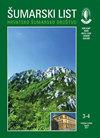克罗地亚窄叶白蜡(Fraxinus angustifolia Vahl)和绿白蜡(Fraxinus pennsylvanica Marshall)种子昆虫的初步研究
IF 0.4
4区 农林科学
Q4 FORESTRY
引用次数: 0
摘要
原生窄叶灰(Fraxinus angustifolia Vahl)和引进绿灰(f.p nsylvanica Marshall)是克罗地亚低地森林中最常见的两种灰(Fraxinus spp.),在这些生态系统中占有重要地位。在最近的过去,人们观察到窄叶白灰种子的产量减少了,这强调了收集到的白灰种子的良好健康状况的重要性,因为它们被用来生产幼苗和连续更新林分或造林。鉴于昆虫可能是影响白蜡树种子健康状况的重要因素,本研究的目的是深入了解白蜡树种子中存在的物种及其频率。对来自7个不同地点的2500个窄叶白蜡树种子和1000个绿白蜡树种子进行了昆虫存在筛选。将分析的种子分为未损伤、昆虫损伤和空种子,并对观察到的昆虫标本进行形态和分子遗传鉴定。与本地白蜡树相比,绿白蜡树种子显示出更高的虫害,其中象鼻虫Lygniodes bischoffii是发现的数量最多的害虫。窄叶白蜡树种子主要被本地象鼻虫L. enucleator占据。除这些害虫外,两种白蜡树均有寄生蜂(膜翅目)的幼虫、蛹和成虫期,以及食种蛾(鳞翅目)的幼虫期。然而,考虑到本研究中发现的害虫倾向于在城市地区或在极少数种子中存在,而在这些种子中往往伴随着寄生蜂,因此可以得出结论,昆虫目前对森林林分中窄叶白蜡和绿白蜡的繁殖没有显著的负面影响。本文章由计算机程序翻译,如有差异,请以英文原文为准。
Preliminary results on narrow-leaved ash (Fraxinus angustifolia Vahl) and green ash (Fraxinus pennsylvanica Marshall) seed entomofauna in Croatia
Native narrow-leaved ash (Fraxinus angustifolia Vahl) and introduced green ash (F. pennsylvanica Marshall) are two most common ash (Fraxinus spp.) species in Croatian lowland forests, taking a significant place in these ecosystems. In the recent past it has been observed that narrow-leaved ash seed yields have reduced, emphasising the importance of good health status of those collected, as they are used for seedling production and consecutive regeneration of forest stands or afforestation. Given that insects could be an important factor affecting ash seed health status, the aim of this research was to gain insight into the species being present and their frequency in the ash seeds. In total 2.500 narrow-leaved ash and 1.000 green ash seeds from seven different locations were screened for insect presence. Analysed seeds were categorized as undamaged, insect damaged or empty, and observed insect specimens were identified by morphological and molecular genetic analysis. Green ash seeds revealed higher insect infestation in comparison with native ash species, with weevil Lygniodes bischoffii being the most numerous pest found. Narrow-leaved ash seeds were mostly occupied by the native weevil species, L. enucleator. Besides these pests, larval, pupal, and adult stages of parasitoid wasps (Hymenoptera) and larval stage of the seed eating moth Pseudargyrotoza conwagana (Lepidoptera) were found in both ash species. However, given that pests detected in this study prefer urban areas or were present in a very small number of seeds, where they were often followed by parasitoids, it can be concluded that insects currently do not have a significant negative impact on the reproduction of narrow-leaved ash and green ash in forest stands.
求助全文
通过发布文献求助,成功后即可免费获取论文全文。
去求助
来源期刊

Sumarski List
FORESTRY-
CiteScore
0.90
自引率
20.00%
发文量
32
审稿时长
>12 weeks
期刊介绍:
Forestry Journal publishes scientific and specialist articles from the fields of forestry, forestry-related scientific branches, nature protection and wildlife management.
 求助内容:
求助内容: 应助结果提醒方式:
应助结果提醒方式:


